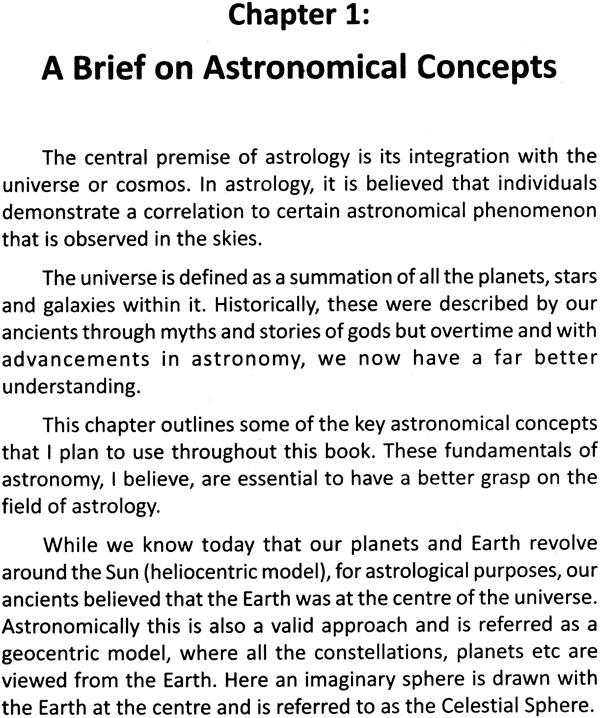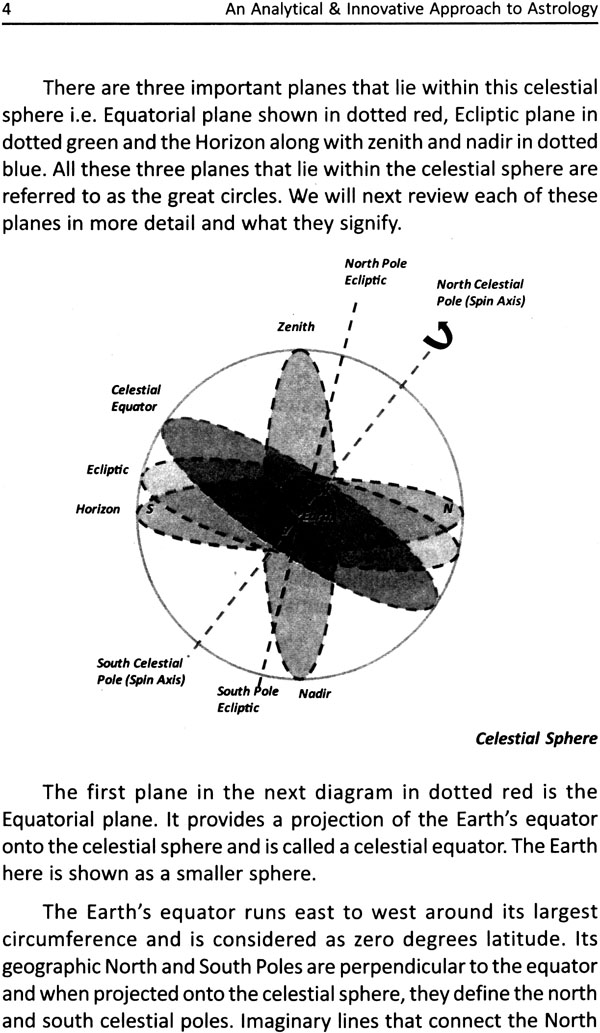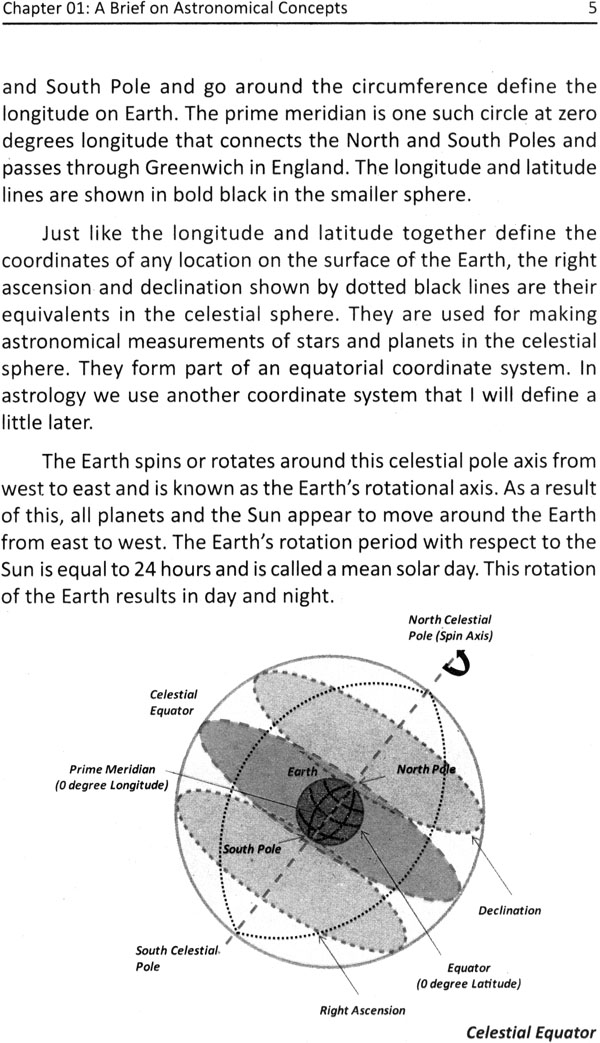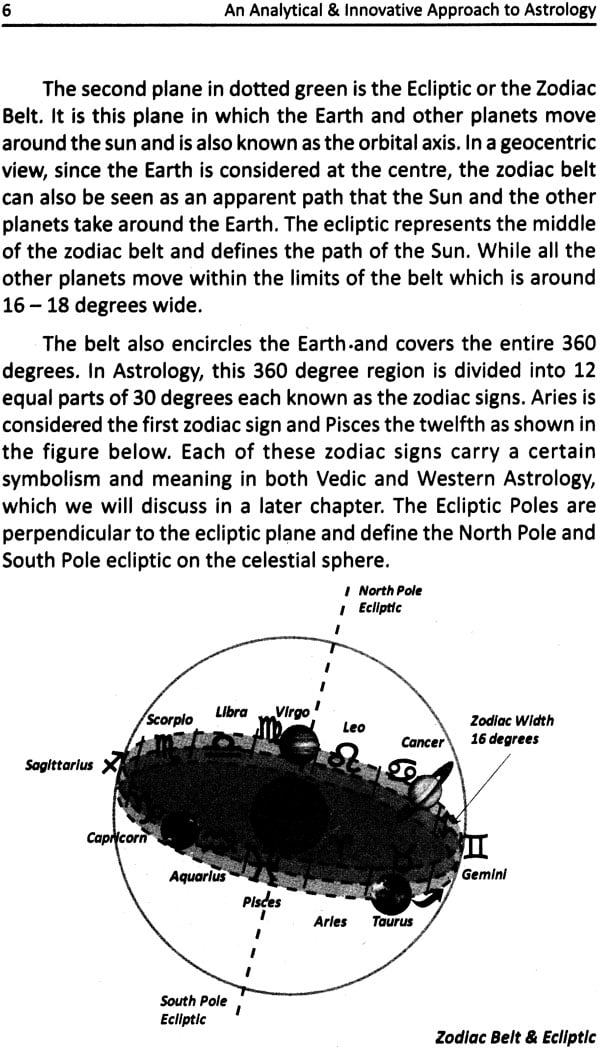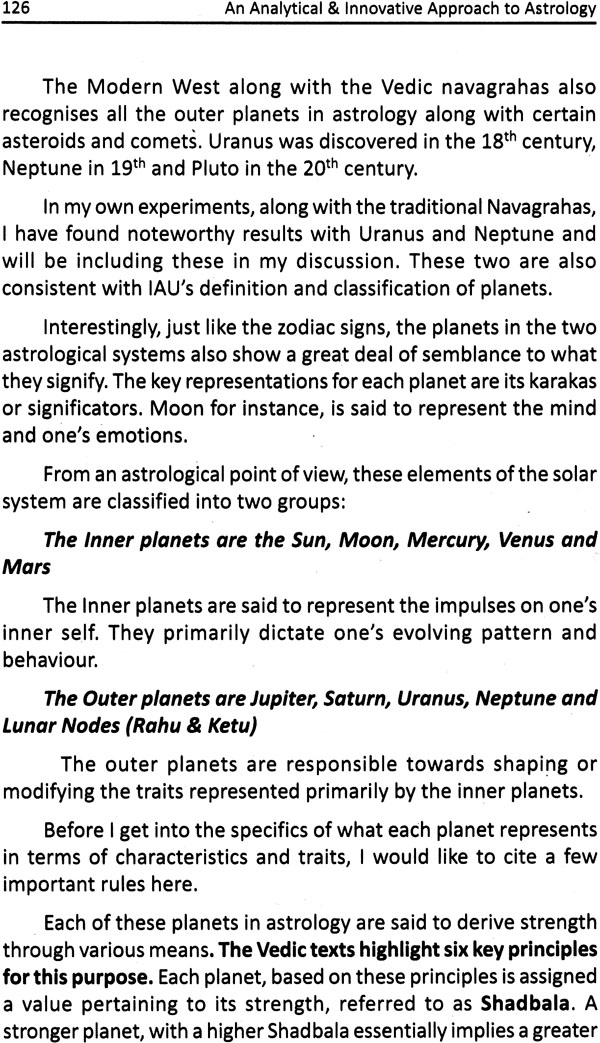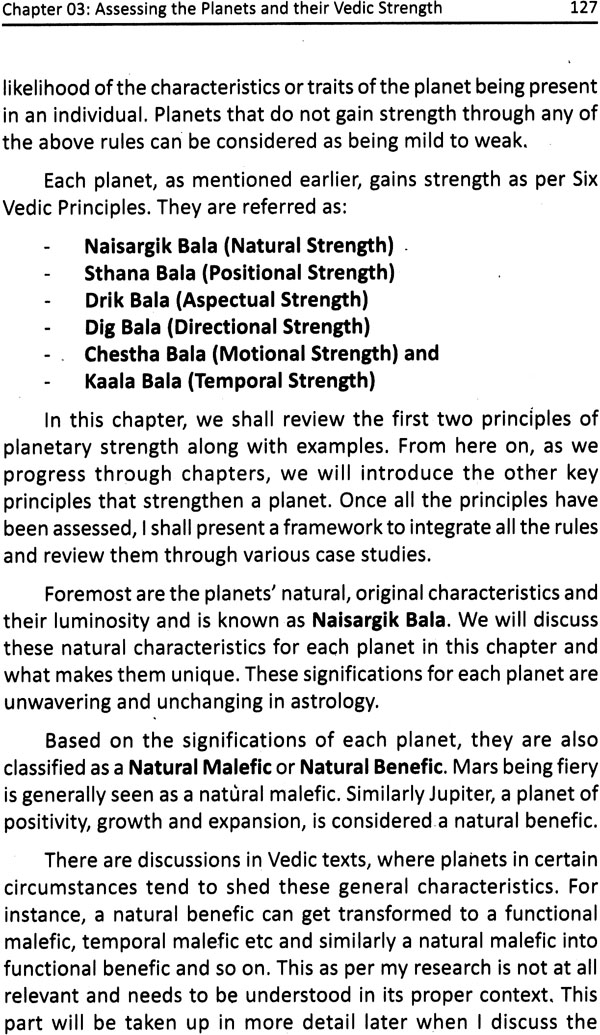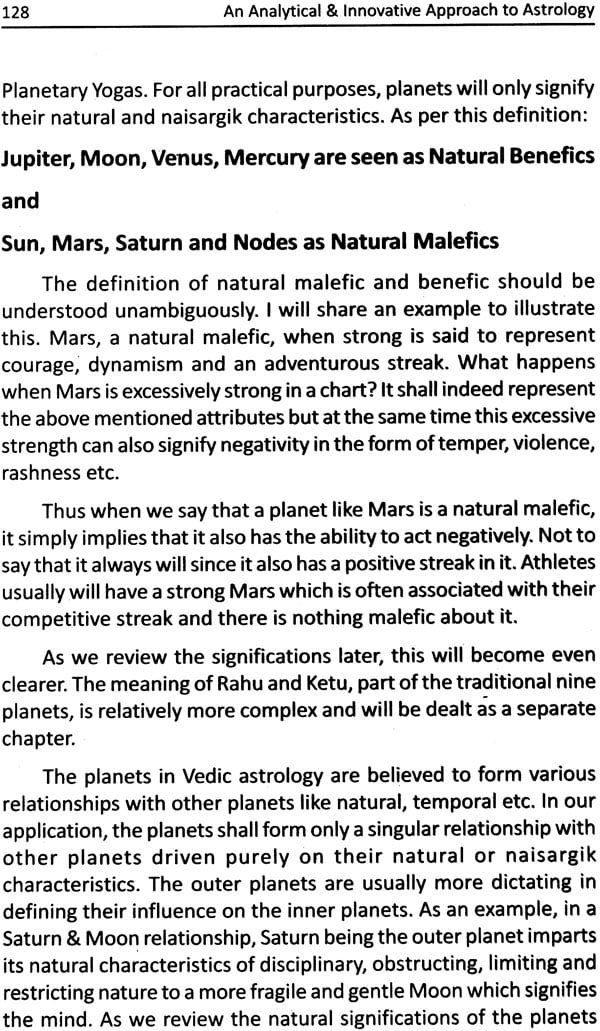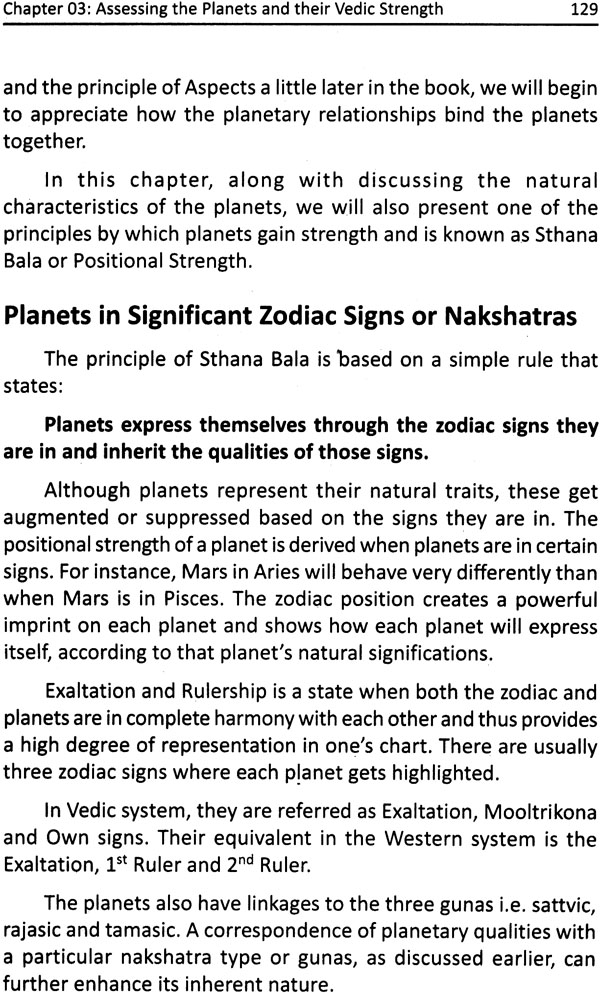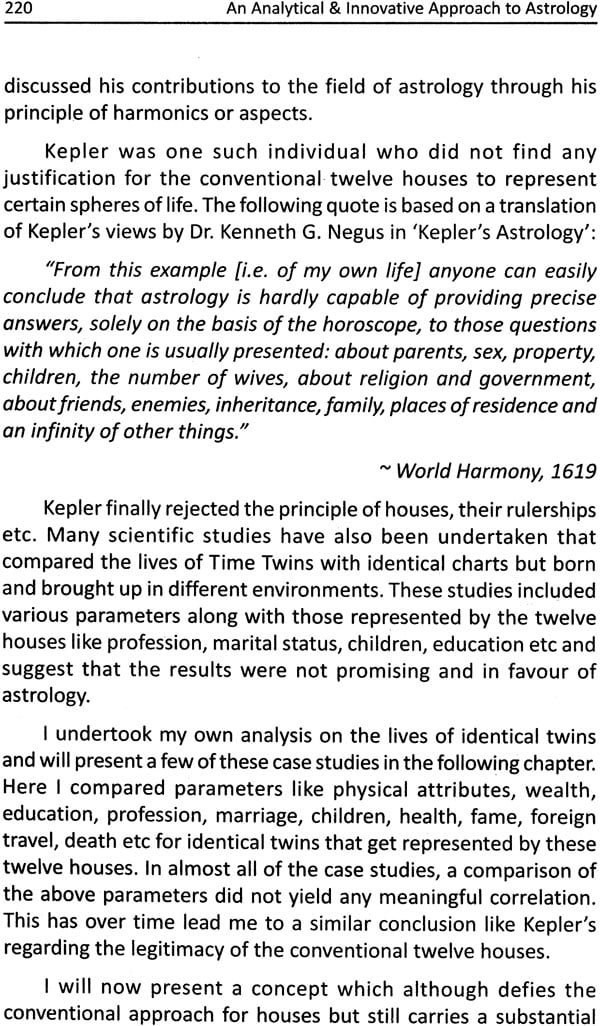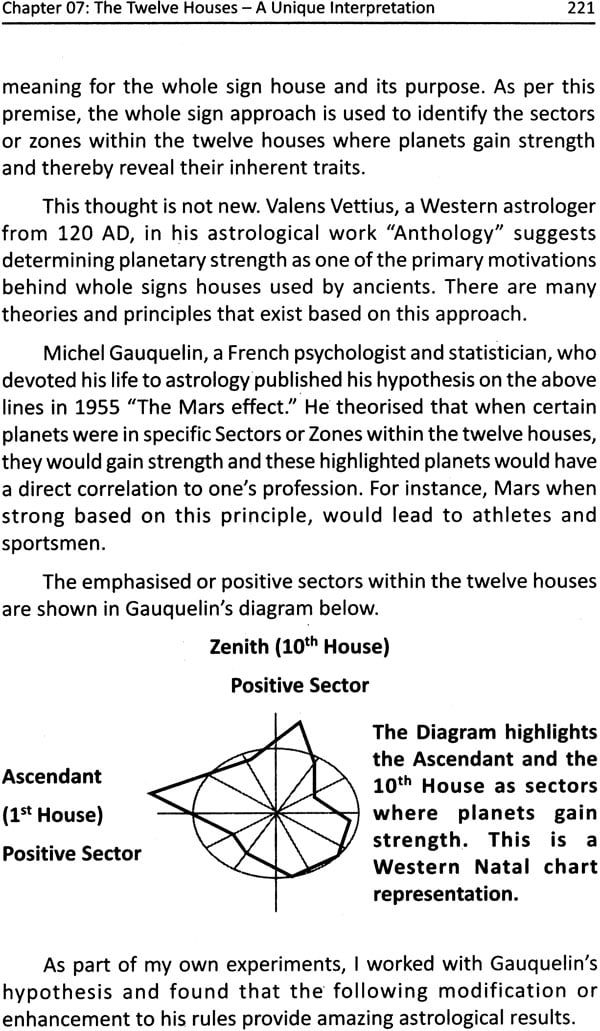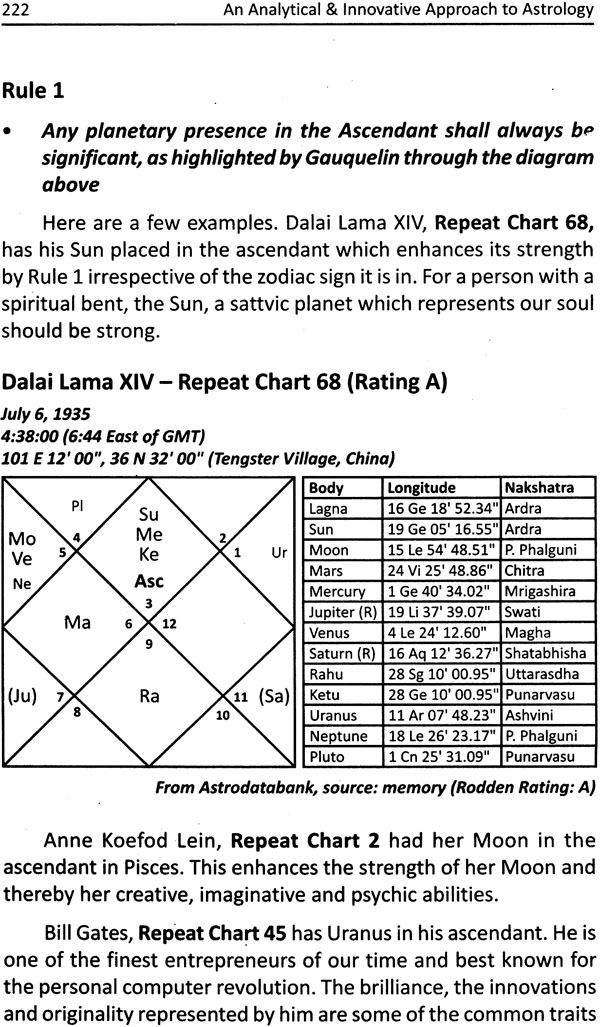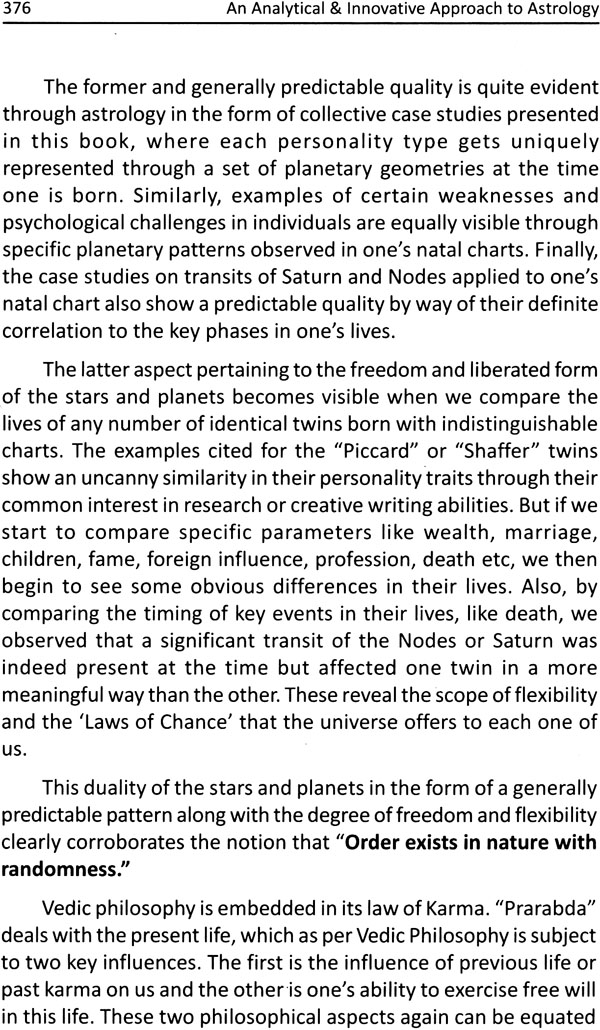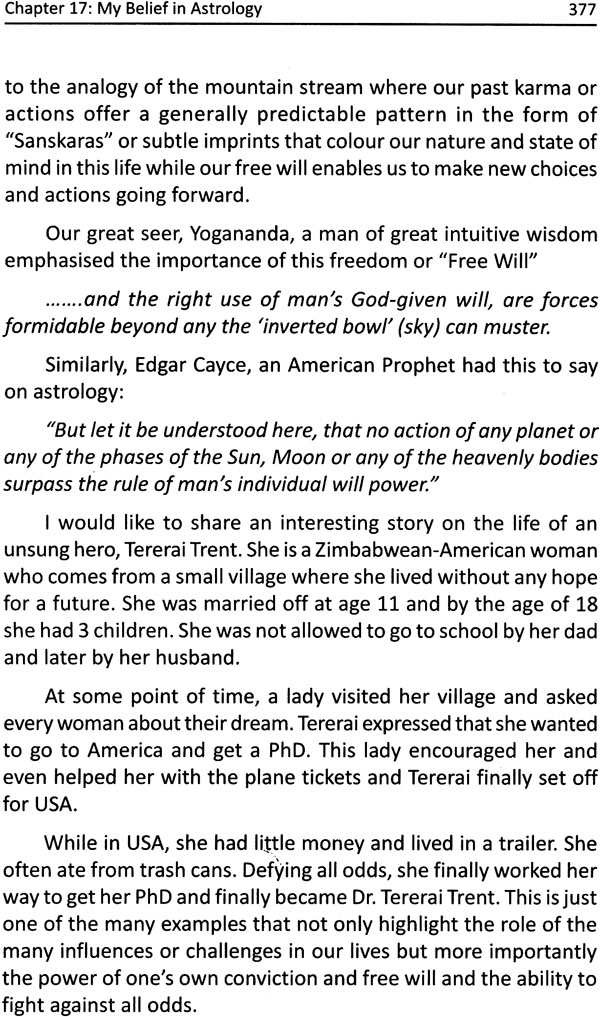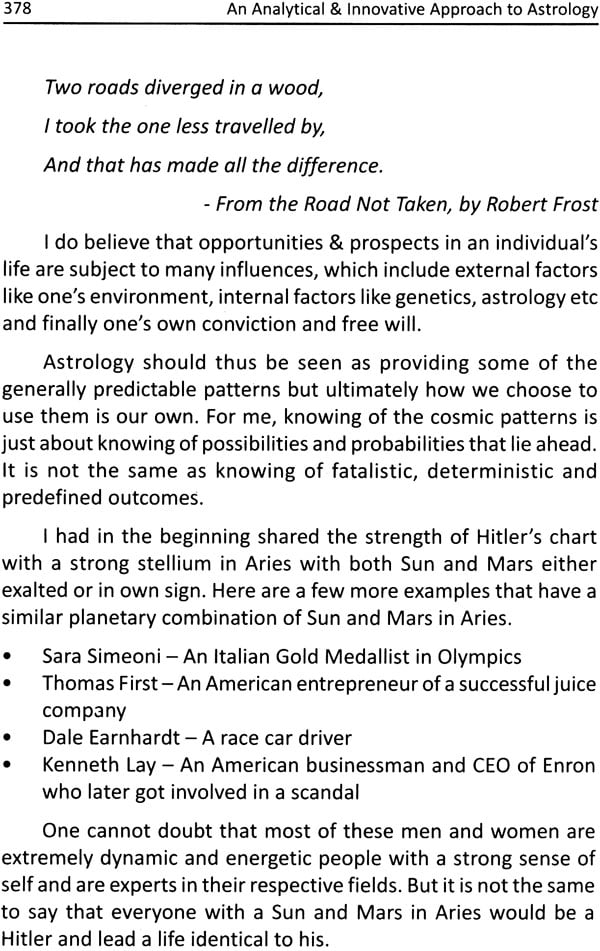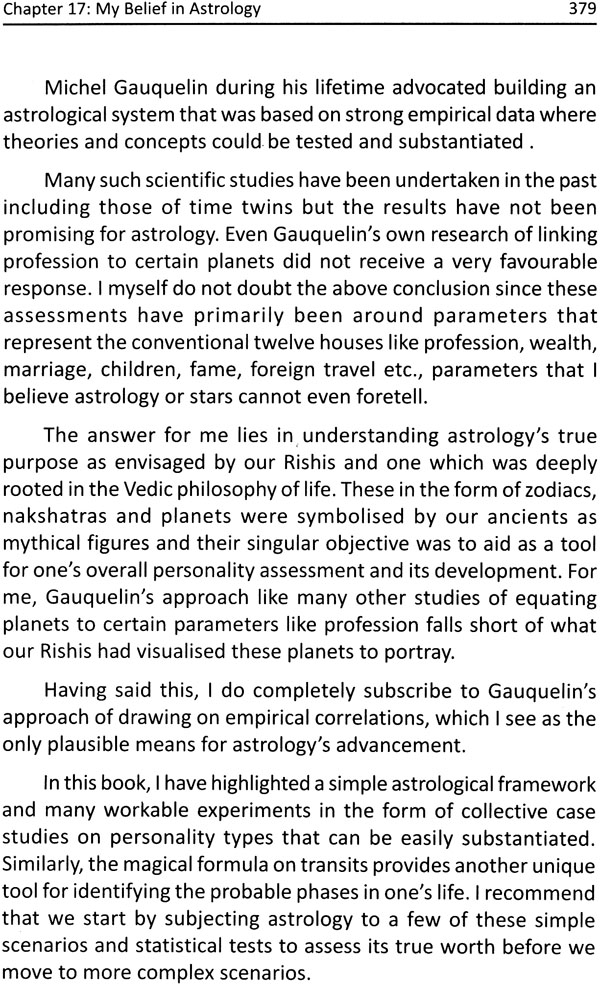
An Analytical and Innovative Approach to Vedic Astrology (Explained through authentic charts and case studies)
Book Specification
| Item Code: | NAD075 |
| Author: | Ashish Gujral |
| Publisher: | SAGAR PUBLICATIONS |
| Language: | English |
| Edition: | 2012 |
| ISBN: | 9788170821380 |
| Pages: | 407 |
| Cover: | Paperback |
| Other Details | 8.5 inch 5.4 inch |
| Weight | 510 gm |
Book Description
I have grown up in India and am an alumni of India Institute of Technology, Roorkee, India; University of Michigan, Ann Arbor, USA; and Pennsylvania State University, State College, USA. I am an engineer by profession and have worked in the Telecom industry for about 20 years with several multinational organizations, both in India and the USA.
I took up astrology as a pastime around ten years back. I started by reading books on Vedic Astrology. Having an analytical bent of mind lead me to question Astrology and its principles at every level. This journey for me has been about finding answers to some of the key issues facing astrology.
Does Astrology really work? Can we prove it? What can it truly deliver?
At some point, as part of this quest, I got into reading books on Western Astrology. For me, this was a turning point in more ways than one. It not only presented a whole new dimension on how this subject is viewed by the West but what I found really intriguing was the strong synergy that existed between the Vedic and Western principles.
My fascination for research and curiosity to ”know the unknown” has taken the form of this book. It is my sincere attempt to integrate the learning’s of East and West using an analytical and innovative approach to astrology. It dissects the hundreds of complex rules available in Vedic and Western texts to a few simplistic principles explained through numerous case studies.
I am also greatly drawn towards its application in the field of Medical astrology. My research on this subject is underway and I do wish to present this a s a second book at some point of time.
Astrology was a chance for me. It was the spring of 2002 and I had returned from a vacation with the family. One morning just idling n the house, I faltered upon a collection of books on Vedic Astrology that my dad used to read. I got into reading them and soon acquired an interest in the subject. It must have been my curiosity towards “knowing the unknown.” I was also intrigued by the predictive ability of Vedic astrology and of being able to foretell one’s future.
Each book I read, dealt with a new astrological principle, a new way of thinking and I felt that these new concepts would finally lead me towards comprehending this subject better. Soon I found that a composite of books that I read had pretty much dealt with all sorts of permutations and combinations between planets, zodiac signs, nakshatras, houses, aspects, dashas etc and towards analysing natal charts.
I now began to see the underlying complexity that existed in astrology with a multitude of astrological principles, predictive techniques and interpretative methods. A particular logic would work on one birth chart but not another. The applicability of these principles on charts became quite arbitrary as it required applying different concepts at different times to establish a point. I am sure anyone who has dealt with this subject for a sufficient period of time can empathise with how I felt.
I felt what astrology required was a more simplistic yet objective approach towards its interpretive and predictive abilities. For me, it meant being able to define a set of simple rules that could be applied time and again on a consistent basis for each and every astrological chart.
An analytical approach to astrology is all the more important as this subject today does not have any locus standi with the scientific community. As per Stephen Hawking, scientists don’t believe in astrology because it is not consistent with the theories that have been tested by experiment. This book is written keeping this aspect in mind that our theories and concepts for astrology must be built on evidence and not just belief. The intent of this book is not to capture the meaning of the Vedic sloka’s or the numerous astrological principles verbatim but to actually try and get to the heart and essence of this subject. The fact that astrology is deeply rooted in the Vedic philosophy of life, especially the laws of Karma, offers some interesting clues to its true purpose. These in the form of zodiacs, nakshatras and planets were symbolised by our ancients as mythical figures and their singular objective was to aid in one’s overall personality and spiritual development.
VIII Vedic Astrology or Jyotisha means to illuminate. It deals with the study of astronomy and astrology. The earliest references, which are purely astronomical in nature, are found in the Vedas and later in the Vedangas. The Vedas are said to have originated around 2nd millennium BC but the exact time period is not known. The Vedanga, one of the six limbs of Vedas, which was written much later is referenced in an astrological text, the Brihat Samhitä and link its time period to around 1300 BCE. In a natal astrological context, the oldest Vedic reference is the Yavanajataka in Sanskrit believed to have been written much later and around 150 CE. The other main texts that are commonly referred are Brihat Parashara Hora Shastra of Parashara, Brihat Jataka, Saravali, Bhrigu Sutras and Jaimini Sutras.
For western natal astrology, Ptolemy, a Greek, is considered the authority with “Tetrabiblos” as the reference text that was written by him in 2 century AD. Its initial form is believed to have developed among the ancient Babylonians around the second millennium B.C. Mul.Apin is the reference text that deals with Babylonian astrology and astronomy and dates back to around
ix 700 BC. Historians believe that this reference text presents the first traces of the twelve zodiac signs as recognised in astrology today.
My research in the form of this book is an attempt to synthesise and build on the collective astrological wisdom of both East and West. This work is an integration of the Vedic and Western principles that I feel provides a very potent perspective to this subject. It shows how two seemingly different systems of astrology are in essence interconnected at the core. I will present these synergies through the course of this book where one can begin to draw parallels between the principles of East and West.
As part of this effort, the most enduring part for me was my own Initial bias and expectations of astrology. I had a certain belief system and pre-disposition towards its workings and what it could deliver. To keep undoing and letting go of these belief’s that did not satisfy me anymore was very difficult and I consider my greatest achievement as part of this journey. I have a chapter later in the book on “My Belief in Astrology” where I will present my current understanding of this subject and what I consider it can truly deliver. As someone has said, if we value knowledge we must be free to follow wherever that search may lead us and not have any predetermined notions about it.
This book is intended towards intermediate and advanced students of astrology and even for psychologists. I have a section on key astronomical concepts as I believe that these are essential for one to do justice to the field of astrology. I think this book will best serve those who are willing to experiment and see for themselves what works and what doesn’t. As a prerequisite, I thus seek that we be open in our thought and not have any preset notion about astrology and what it must offer.
I would especially like to thank Paramhansa Yogananda, Johannes Kepler, Cyril Fagan, Carl Jung, Michel Gauquelin, Shri JN Bhasin, Shri CS Patel, Shri Bepin Behari, Shri Prash Trivedi, Shri BV
X Raman, Shri VK Choudhary, Robert Hand, Glenn Perry, David Brawley, Dr. Dennis Harness, Robert Schmidt, Kenneth Browser, David A. Goldstein, Monique Pommier, Shri KN Rao, Barbara Pijan Lama, Pt. Sanjay Rath, Shri G K Goel, Gayatri Devi Vasudev, Shri Krishnamurti, Komilla Sutton, James Braha, Liz Greene, Dr. Kenneth G Negus, Deborah Houlding, Celeste Teal, Noel Tyl, Hassan Jaffer and many others that left an indelible mark on me. Their insights have helped me make an objective assessment on astrology and formulate my own views on this subject.
In this book, have included a total of 100 birth charts from Astrodatabank (www.astro.com/astro-databank). I must acknowledge Lois Rodden, Astrodatabank and Astrodienst team who not only worked towards building such an incredible database but for also making it accessible to all. Most of the natal charts carry the highest Rodden rating of AA and are thus authenticated with proper birth records. Each chart lists the source and Rodden Rating. Many errors result in defining a birth chart due to software tools providing their own interpretation of time zones, daylight saving time (DST), latitude and longitude etc. One has to be extra careful here as I believe that being able to preserve the accuracy of every natal chart with proper birth date, time and location is sanctimonious to astrology. Each of these examples illustrated a particular concept and have been very carefully selected to present a particular theme. There are only handful exceptions where the highest AA rating for charts has not been used. These have been properly illustrated where applicable but more importantly they are used to explain a certain principle that may not have as strong a bearing on a precise birth time.
I would also like to acknowledge Anatoly Zaytsev and Shri PVR Narasimha Rao for not only building incredible astrological software tools like “ZET” and “Jagannath Hora” but got also making them readily accessible as a freeware option towards the advancement of this field.
Xi I genuinely feel that the research in the form of this book has reached a point where it is worthy of your review and criticism. I hope you will find enough substance in the book that at least provided me with many ‘Eureka’ moments.
Another area of significant relevance and importance for me within the purview of astrology is its medical application. This last topic really fascinates me. India is a developing country and I see how the common man has to struggle to cope with huge bills towards medical diagnosis and treatments. I have already started to work on this part and I do wish to present this research on medical astrology as part of my second book.
| Description | |
| Author’s Preface | ix |
| Section 1—The Concepts Defined | 1 |
| 1 A Brief on Astronomical Concepts | 3 |
| 2 Integrating Zodiac & Nakshatras | 32 |
| 3 Assessing the Planets and their Vedic Strength | 124 |
| 4 The Significant Aspects in Astrology | 167 |
| 5 Powerful Stellium or Yuti—A Few Examples | 187 |
| 6 The Lunar Nodes—A True Vedic Wonder | 194 |
| 7 The Twelve Houses—A Unique Interpretation | 218 |
| 8 Few Case Studies on Identical Twins | 238 |
| 9 Assessing a Few Important Yogas in Vedic Astrology | 246 |
| Description | |
| Section II—The Concepts Defined | 257 |
| 10. Method for Analysing Charts—the Framework | 259 |
| 11 Collective Case Studies on Personality Types | 269 |
| 12 Assessing Weakness in a Chart | 294 |
| Section III—The Concepts Defined | 307 |
| 13 The Magical Formula for Timing through Transits | 309 |
| 14 Case Studies on Predicative cycles using Transits | 323 |
| 15 Mitigating the Transitory Influence | 353 |
| 16 A Simple Rectification Method for Charts | 359 |
| Section IV—The Concepts Defined | 373 |
| 17 My Belief in Astrology | 375 |
| Appendix | 382 |
